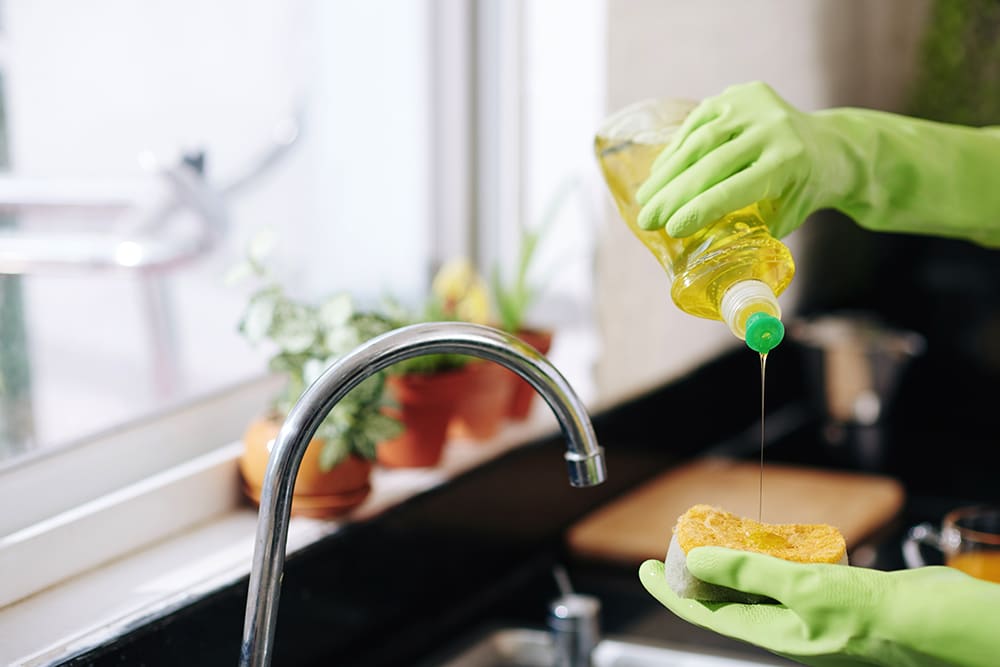Cleaning and disinfecting during the pandemic have probably improved all of our cleanliness habits, but it may be coming at a cost to our health. The cleaning product category is poorly regulated and, as we use more products in an effort to avoid spreading sickness-causing germs, we’re exposing ourselves to harmful chemicals that aren’t safe to come into contact with our skin, eyes, and respiratory systems. In fact, exposure to cleaning chemicals is linked to childhood asthma, both exacerbating symptoms and triggering the condition in people who have never had it. In fact, cleaning chemicals are estimated to cleaning products are estimated to cause 37% of childhood asthma cases. Between bleach, quats, and fragrances, there is some seriously nasty stuff in the cleaning products we use day in and day out. One of the most common toxic ingredient types in cleaning and personal care products are phthalates. Here are the top things to know about these scary compounds and how to find alternatives that will still keep your house clean and disinfected!
Avoiding Phthalates In Cleaning and Disinfecting
Here’s where you’ll find these toxic compounds and why you should avoid them.
What Are Phthalates and Where Do You Find them
If you have plastic in your home, you probably have phthalates, too. This class of chemicals is used to make plastics more flexible and less prone to snapping or breaking. Phthalates also help the scent of a fragrance linger longer, so they’re also found in pretty much all fragranced products. You’ll find phthalates in personal care products like moisturizer and soap products as well as hair sprays and perfumes – and even nail polish. In the cleaning category, you’ll find phthalates in softeners, solvents, fragrances, plasticizers, and PVC (polyvinyl chloride) products. You will even find phthalates in dairy and meat from animals exposed to these compounds and in food that has been packaged in plastic that contains phthalates.
What’s So Bad About Phthalates?
Phthalates are a family of chemicals, so different phthalates behave in different ways – most of them in ways linked to adverse health effects in people and animals. Three phthalates (BBP, DBP, and DEHP) have been banned permanently from toys and pacifiers for children under 3 (who may teethe or suck on them). These phthalates have been found to damage reproductive systems and cause cancer in rats and are suspected to do so in humans as well. In humans, phthalates like DiDP can irritate and injure our skin and eyes and cause nausea, dizziness, and vomiting. DINP is linked to tumors and developmental problems in rats and in California it is considered a chemical known to cause cancer. DnOP is linked to endometriosis in women and reproductive development in rats. DiDP, DINP, and DnOP are all on an interim ban from toys that can go into a child’s mouth. And a recent large study across over 5,000 people linked phthalates to premature deaths – up to 107.000 annually – among adults aged 55-64.
Some of the health risks associated with phthalates include:
- Cancer
- Birth defects
- Respiratory problems
- Behavioral problems in children
- Premature birth
- Genital malformations and undescended testes in baby boys
- Lower sperm counts in men
- Skin irritation and injury
- Eye irritation and injury
How Can You Avoid Phthalates?
It’s difficult to avoid phthalates in cleaning products and personal care products for one main reason. Fragrances are considered trade secrets, which means manufacturers aren’t required to disclose their fragrance ingredients. In fact, the one word “fragrance” on an ingredient label can hide a cocktail of up to 100 sneaky ingredients. Some ways to avoid phthalates are:
- Avoid products that are scented or fragranced. And be wary of “unscented” products, because many of these contain masking fragrances.
- Avoid ingredients with acronyms like DEHP, DBP, BBP, DINP, DiDP, and DnOP
- Plastics with recycling codes 3, 6, & 7
A Phthalate-Free Alternative
Happily, with Force of Nature, you can effectively disinfect and clean your home without the use of phthalates! Force of Nature does not contain fragrances or phthalates. Its anti-microbial ingredient is Hypochlorous Acid (HOCl), which is gentle and effective enough to be used in wound healing, eye care, and veterinary care products. HOCl is as effective as bleach, but gentle enough to be family (and pet) friendly! It’s even certified SkinSafe by the Mayo Clinic. Force of Nature is EPA-registered and appears on the EPA’s List N for use against coronavirus, and has proven to kill 99.9% of viruses and bacteria.
Learn More
It’s hard to find safe products for our homes across all product categories, and, even if you do have time to read every label in the grocery store, it can require a PhD in chemistry to really understand what you’re exposing your family to. As parents, pet-owners, and allergy-sufferers, we knew how important it was to create a disinfectant that families can rely on without harmful chemicals like phthalates. Ready to get started using Force of Nature to clean, disinfect and sanitize virtually everything in your home? Learn more about Force of Nature, and shop for your Starter Kit.




